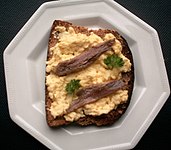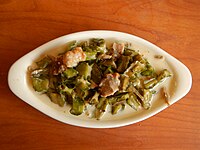Anchovies as food

A traditional method of processing and preserving anchovies is to gut and salt them in brine, allow them to cure, and then pack them in oil or salt. This results in the characteristic strong flavor associated with anchovies, and their flesh turns deep grey. Anchovies pickled in vinegar, as with Spanish boquerones en vinagre, are milder, and the flesh retains a white color. For domestic use, anchovy fillets are sometimes packed in oil or salt in small tins or jars, sometimes rolled around capers. Anchovy paste is also available, as is anchovy essence. Anchovy mash is also sold in the UK under the label of Gentleman's Relish.[3]
They are used in small quantities to flavor many dishes. Because of the strong flavor of anchovies, they are also an ingredient in several sauces, including
Additionally,
Preparation and marketing
The strong taste people associate with anchovies is due to the curing process. Fresh anchovies, known in Italy as alici, have a much milder flavor.[7] The rare alici (anchovies - in the local dialect: "Sardoni barcolani") from the Gulf of Trieste near Barcola, which are only caught at Sirocco, are particularly sought after because of their white meat and special taste and fetch high prices for fishermen.[8]
In Sweden and Finland, the name anchovies is related strongly to a traditional seasoning. Hence, the product "anchovies" is normally made of sprats,[9] while fish such as herring can be sold as "anchovy-spiced", leading to confusion when translating recipes.[citation needed]
The European anchovy, Engraulis encrasicolus, is the main commercial anchovy, with Morocco being the largest supplier of canned anchovies.[10] The anchovy industry along the coast of Cantabria, initiated in Cantabria by Sicilian salters in the mid-19th century, now dwarfs the traditional Catalan salters.[10]
-
Dried Japanese anchovy
-
Salted and fermented anchovy (jeotgal) Korea
-
Canned anchovies
-
Workers handling anchovies in a canning company in Cantabria, Spain
-
Workers cleaning dried anchovies at a market in Mae Sot, Thailand
-
Anchovy at the market, Turkey
Uses
This section needs additional citations for verification. (July 2021) |
In English-speaking countries, alici are sometimes called "white anchovies", and are often served in a weak vinegar marinade, a preservation method associated with the coastal town of Collioure in southwest France. The white fillets (a little like marinated herrings) are sold in heavy salt, or the more popular garlic or tomato oil and vinegar marinade packs.
In
In Southeast Asian countries, anchovies are known as ikan teri in Indonesia, ikan bilis or
In Vietnam, anchovy is the main ingredient in the fish sauce - nước mắm - the unofficial national sauce of Vietnam.[11] In Thai cuisine, dried anchovies are called pla katak haeng. They are used in a variety of dishes and especially popular deep-fried as a snack. Similarly to Vietnamese fish sauce, Thai fish sauce (nam pla) is also often made from anchovies. In other parts of Asia, such as Korea and Japan, sun-dried anchovies are used to produce a rich soup similar to setipinna taty. These anchovy stocks are usually used as a base for noodle soups or traditional Korean soups. There are many other variations on how anchovies are used in Korea.
Fresh and dried anchovies are a popular part of the cuisine in Kerala and other south Indian states, where they are referred to as netholi/chooda (and nethili in Tamil Nadu) and provide a cheap source of protein[12] in the diet. Fresh anchovies are eaten fried or as in a spicy curry.
In Turkey, anchovies are known as hamsi and are eaten between November and March. They are generally consumed fried, grilled, steamed and pilav.[13]
-
Scotch woodcock, scrambled eggs on toast spread with anchovy (United Kingdom)
-
black olives and capers(France)
-
Sambal teri kacang, fried anchovies with peanuts and chili (Indonesia)
-
Anchoa en salazón, anchovy fillets in oil and salt (Spain)
-
Ginataang dilis, anchovies with winged beans and pork stewed in coconut milk with spices (Philippines)
Health concerns
Anchovies can concentrate domoic acid in their gut which causes amnesic shellfish poisoning in humans when eaten whole. If suspected, medical attention should be sought.[14]
See also
References
- ^ "What's an oily fish?". Food Standards Agency. 2004-06-24. Archived from the original on 2010-12-10. Retrieved 2012-04-15.
- ^ Froese, Rainer, and Daniel Pauly, eds. (2008). "Engraulidae" in FishBase. December 2008 version.
- ^ Two Fat Ladies cooking show
- ^ Belfast, Frederick Richard Chichester Earl of (1856). Naples: Political, Social, and Religious. T. C. Newby.
- ^ "Tacitus: Germania". thelatinlibrary.com.
- ^ Enns, Darren. "Fishing With Anchovies". Fishin Money- Fishing Tips. Retrieved 2021-05-21.
- ^ "White Anchovy Fillets (Boquerones)". marxfoods.com.
- ^ Georges Desrues "Eine Lange Nacht am Meer", In: Triest - Servus Magazin (2020), p 73.
- ^ "Food: First catch your anchovies". The Independent. 22 November 1997. Archived from the original on 2009-07-14.
- ^ a b "Homage to the Anchovy Coast". Smithsonian.
- ^ Kuronuma, Katsuzo (1961). A Check List of Fishes of Vietnam. U.S. Operations Mission to Vietnam.
- ^ "Dangers of eating anchovies". Pharmaceutical Journal. Retrieved 2018-07-05.
- ^ "Hamsi". Archived from the original on 2012-05-01. Retrieved 2012-04-15.
- ^ Domoic Acid Poisoning Archived 2012-02-13 at the Wayback Machine Northwest Fisheries Science Center, NOAA. Retrieved 16 July 2012.
External links
- Chisholm, Hugh, ed. (1911). . Encyclopædia Britannica (11th ed.). Cambridge University Press.
- Consider the anchovy Guardian, 18 January 2011.
- The height of good paste The Telegraph, 28 December 2000.












